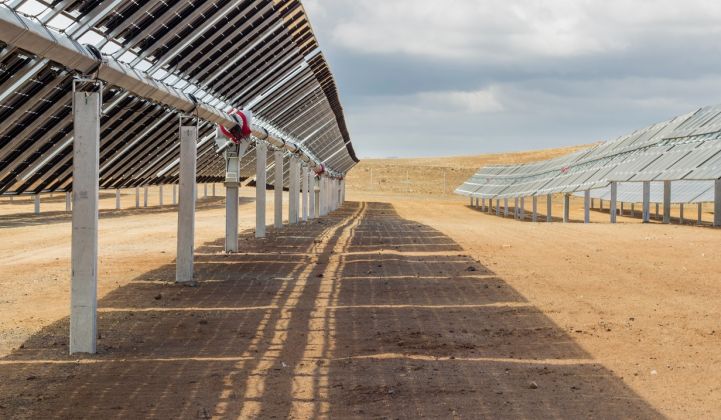Canadian Solar announced a 1.8-gigawatt module order from EDF Renewables North America on Wednesday, the largest in its history, in a deal analysts say points to the utility solar market’s looming pivot toward bifacial technology.
Canadian Solar says it will supply a mixture of its bifacial and traditional modules to multiple EDF projects across the U.S., Canada and Mexico through 2023, as the U.S. federal Investment Tax Credit (ITC) phases down.
Bifacial modules, which generate more electricity than traditional modules by absorbing sunlight on their backside, represent a sliver of the overall solar market today. But many in the industry expect them to catch on quickly over the next few years, helping to lower the levelized cost of solar power as developers and investors grow more comfortable with the technology.
“The agreement demonstrates our confidence in the bifacial module technology to support our robust pipeline of contracted projects over the next five years,” Tristan Grimbert, president and chief executive of EDF Renewables North America, said in a statement.
There were just 3.1 gigawatts of bifacial modules installed globally at the end of 2018, or less than 1 percent of the worldwide total, according to Ben Gallagher, senior solar analyst at Wood Mackenzie Power & Renewables.
Even as momentum builds for the technology, bifacial modules are expected to account for just under 5 percent of global solar installations this year, Gallagher said. “But this announcement from EDF is a clear indication that in the near term, bifacial will make up a much more substantial portion of PV installations, especially here in the U.S.”
Demand for bifacial modules is expected to grow as more projects are completed using the technology, establishing a track record investors can point to. Among other projects underway, Invenergy is building a 160-megawatt solar array in Georgia using bifacial modules supplied by China’s Longi, due for completion later this year.
Canadian Solar launched its bifacial modules onto the market a year ago, claiming they can generate 30 percent more power than conventional modules under the right conditions.
EDF’s order is the single largest in Canadian Solar’s 18-year history, said chief executive Shawn Qu. The vertically integrated company — which is a large developer through its Recurrent subsidiary in addition to its manufacturing business — shipped 6.6 gigawatts of modules in 2018, and has guidance of up to 7.8 gigawatts this year.
EDF Renewables North America, the San Diego-based unit of France’s EDF group, is among the largest developers of both wind and solar capacity in the U.S.
EDF’s order comes as U.S. solar developers are finalizing their strategies for dealing with the step-down of the ITC, which will fall from 30 percent for projects qualified in 2019 to 10 percent for large-scale projects qualifying in 2022 and onward.
Developers have two options for qualifying projects in a given year: They can start construction, or they can “safe-harbor” a project by spending 5 percent of its total cost, often by stockpiling modules. Since being given favorable guidance by U.S. tax authorities, most developers are aiming to safe-harbor their entire contracted pipelines, according to WoodMac.
In anticipation of steeper prices for high-efficiency modules in the quarters and years ahead, some developers may look to sign big procurement deals along the lines of EDF’s — a strategy many U.S. wind developers adopted as their main tax credit began phasing down. WoodMac expects the global PV module market to tighten significantly in late 2019.
The looming ITC step-down is already driving orders in the U.S. market, Canadian Solar’s Qu said.
“As the U.S. market recovers from the uncertainties brought by Section 201 tariffs and rushes to meet the step-down of the Investment Tax Credit deadline, we are seeing a significant rebound of demand in the U.S. solar market, which impacts module supply across the entire region.”




